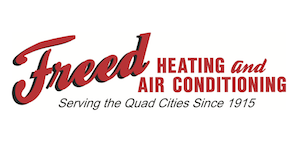
You shouldn’t need to give up comfort or drain your wallet to keep your home at a pleasant temperature during warm days.
But what is the ideal temperature, exactly? We review ideas from energy experts so you can select the best setting for your house.
Here’s what we suggest for the most energy-efficient setting for air conditioning in Moline.
Recommended Thermostat Settings for Summer
Most families find setting the thermostat at 72-73 degrees is most comfortable. However, if there’s a sizeable difference between your interior and exterior warmth, your utility costs will be greater.
These are our recommendations based on the U.S. Department of Energy (DOE) and ENERGY STAR®.
While at home: 78 degrees. While that seems warm, there are ways you can keep your house cool without having the AC running all the time.
Keeping windows and window treatments down during the day keeps cold air where it should be—within your home. Some window coverings, including honeycomb shades or plantation shutters, are created to give more insulation and enhanced energy efficiency.
If you have ceiling fans in your home, the DOE says you can raise thermostat settings about 4 degrees hotter without sacrificing comfort. That’s because they refresh by a windchill effect. As they cool people, not rooms, switch them off when you exit a room.
If 78 degrees still appears too warm on the surface, try doing a test for a week or so. Start by upping your thermostat to 78 degrees while you’re at your house. Then, steadily turn it down while following the advice above. You may be amazed at how comfortable you feel at a hotter temperature setting.
While away: 88 degrees. There’s no need to keep the air conditioner going all day while your house is empty. Moving the setting 7–10 degrees hotter can save you anywhere from 5–15% on your air conditioning bills, according to the DOE.
When you arrive home, don’t be tempted to set your thermostat under 78 to cool your home more rapidly. This isn’t useful and often leads to a more expensive AC expense.
A programmable thermostat is a useful method to keep your temp controlled, but it requires setting programs. If you don’t set programs, you might forget to raise the set temperature when you go.
If you want a convenient resolution, think about getting a smart thermostat. This thermostat connects with your phone, so it realizes when you’re at your house and when you’re away. Then it intuitively adjusts temperature settings for the biggest savings. How much exactly? Usually $180 annually on heating and cooling, according to ENERGY STAR.
Another perk of having a smart thermostat? You can use your phone to keep an eye on and change temperature settings from nearly anywhere.
While sleeping: Around 70 degrees. While ENERGY STAR advises 82 degrees, that could be unpleasant for many families. Many people sleep better when their bedroom is chilled, so that’s why the National Sleep Foundation recommends 60–67 degrees. But that might be too cold, based on your pajama and blanket preference.
We advise trying a comparable test over a week, setting your temperature higher and steadily lowering it to choose the ideal temperature for your house. On pleasant nights, you may find keeping windows open at night and running a ceiling fan is a preferable option than operating the AC.
More Approaches to Save Energy During Warm Weather
There are extra ways you can conserve money on AC bills throughout warm weather.
- Install an energy-efficient AC system. Central air conditioners only last about 12–15 years and get less efficient as they age. A new air conditioner can keep your house cooler while keeping electricity expenses down.
- Set regular air conditioner tune-ups. Annual air conditioner maintenance keeps your equipment operating like it should and could help it work at better efficiency. It might also help lengthen its life expectancy, since it enables professionals to spot little troubles before they cause a major meltdown.
- Change air filters often. Follow manufacturer instructions for replacing your air filter. A dirty filter can lead to your system short cycling, or turn on and off too often, and raise your electrical.
- Inspect attic insulation levels. Just about 90% of homes in the USA don’t have proper insulation, according to the Insulation Institute. Most southern climates require 13–14” of attic insulation, while northern climates need 16–18”.
- Have your ductwork checked. Ductwork that has separated over time can leak cold air into your attic, walls or crawl space. This can create major comfort troubles in your home, such as hot and cold spots.
- Seal openings, doors and windows. Keep warm air where it belongs by closing cracks. You can also caulk or weather strip doors to trap more cold air within your home.
Save More Energy During Warm Weather with Freed Heating & Air Conditioning
If you want to conserve more energy during warm weather, our Freed Heating & Air Conditioning professionals can provide assistance. Give us a call at 309-323-9584 or contact us online for additional details about our energy-saving cooling products.
